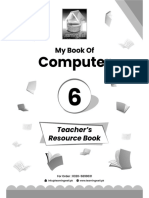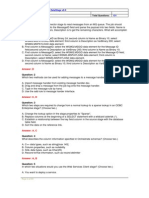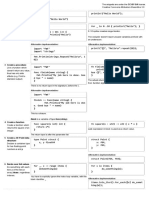What Is Operating System
Uploaded by
dghelp1234What Is Operating System
Uploaded by
dghelp12341.
1.1.
2.
2.1. Explain the window operating system
2.2. develop files and folders
2.3. manage files and folders
2.4. use common keyboard shortcuts to speed up operation
2.5. use window’s Help
2.6. Install/ Uninstall Software
2.7. Copy and burns cds and dvds
2.8. Carry out zipping and unzipping files and folders
2.9. Use browser with internet
2.10. Use email applications
2.11. Use antivirus software
2.12. Demonstrate scanning of photographs and attaching it with email as
correspondence
2.13. Determine the ways to sort out fix minor computer issues by using control panel
options and basic troubleshooting guidelines.
2.14. Explain usage and understanding of an operating system
2.15. Explain the importance of defragmenting a drive for optimum usage and speed and
demonstrate same .
2.16. List of different type so files (common files extensions used)
2.17. Demonstrate the procedure of finding / sorting/ archiving files
1. Windows Operating System:
The Windows Operating System is a user-friendly and popular operating system developed by
Microsoft. It provides a graphical user interface (GUI) that allows users to interact with their
computer using icons, menus, and windows. It supports multitasking, allowing users to run multiple
programs simultaneously. Windows also includes built-in security features such as user accounts and
file permissions. To learn more about the Windows Operating System, a recommended book is
"Windows 10 For Dummies" by Andy Rathbone.
2. File and Folder Development:
Developing files and folders involves creating, organizing, and structuring data and information on a
computer. Users can create files to store text documents, spreadsheets, presentations, and other
types of data. Folders are used to group related files together, making it easier to locate and manage
them. Understanding file naming conventions, file formats, and file organization techniques are
essential for effective file and folder development. For further study, "Windows 10 Inside Out" by Ed
Bott and Carl Siechert is a comprehensive guide to Windows file management.
3. File and Folder Management:
Once files and folders are created, managing them efficiently is crucial. This involves tasks such as
copying, moving, and deleting files, as well as organizing them within folders. Windows provides
various tools and techniques to help manage files and folders, including search functionality, file
properties, and drag-and-drop operations. Learning how to use these features effectively can save
time and improve productivity. "Windows 10 Simplified" by Paul McFedries is a recommended book
that covers file and folder management in a clear and concise manner.
4. Common Keyboard Shortcuts:
Using keyboard shortcuts is a convenient way to perform tasks quickly without relying solely on the
mouse. Windows offers a wide range of keyboard shortcuts that can be used to navigate the
operating system, perform actions on files and folders, and access various features and functions.
Memorizing and utilizing these shortcuts can greatly speed up operation and increase efficiency.
"Windows 10: The Missing Manual" by David Pogue is a comprehensive resource that covers
keyboard shortcuts and many other aspects of Windows usage.
You might also like
- Attendance RX Network Installation Troubleshooting Guide: Server - Client Communication FailureNo ratings yetAttendance RX Network Installation Troubleshooting Guide: Server - Client Communication Failure2 pages
- Introduction To Information Technology - Lecture 1 PDF71% (7)Introduction To Information Technology - Lecture 1 PDF28 pages
- 6.introduction To Working With Windows Operating SystemNo ratings yet6.introduction To Working With Windows Operating System6 pages
- Windows_10_Training_Roadmap_Further_UpdatedNo ratings yetWindows_10_Training_Roadmap_Further_Updated4 pages
- Configuring Windows Devices) : Module 1: Overview of Windows 10this Module Introduces The Windows 10 OperatingNo ratings yetConfiguring Windows Devices) : Module 1: Overview of Windows 10this Module Introduces The Windows 10 Operating11 pages
- Windows 11 for Seniors: The Step-by-Step Beginners Guide to Mastering Windows 11From EverandWindows 11 for Seniors: The Step-by-Step Beginners Guide to Mastering Windows 11No ratings yet
- I Am Sharing 'Information and Communication Technology (ICT) Skills' With YouNo ratings yetI Am Sharing 'Information and Communication Technology (ICT) Skills' With You12 pages
- A Simple Guide to Windows XP Gilles Fouchard download100% (2)A Simple Guide to Windows XP Gilles Fouchard download56 pages
- Introduction To Computing Skills AssignmentNo ratings yetIntroduction To Computing Skills Assignment3 pages
- 01 Self Management Skills II Revision NotesNo ratings yet01 Self Management Skills II Revision Notes7 pages
- MLCL193-01 Computer Literacy (Microsoft) Learning Manual - V1.0 Apr 2018 PDFNo ratings yetMLCL193-01 Computer Literacy (Microsoft) Learning Manual - V1.0 Apr 2018 PDF961 pages
- Expert Linux Administration Guide: Administer and Control Linux Filesystems, Networking, Web Server, Virtualization, Databases, and Process Control (English Edition)From EverandExpert Linux Administration Guide: Administer and Control Linux Filesystems, Networking, Web Server, Virtualization, Databases, and Process Control (English Edition)3/5 (2)
- Basic Knowledge on Computer and Its ApplicationsNo ratings yetBasic Knowledge on Computer and Its Applications30 pages
- Computer Basics Windows and File ManagementNo ratings yetComputer Basics Windows and File Management14 pages
- M206971 - Installing and Configuring Windows 10No ratings yetM206971 - Installing and Configuring Windows 105 pages
- A Simple Guide to Windows XP Gilles Fouchard - The complete ebook is available for download with one click100% (2)A Simple Guide to Windows XP Gilles Fouchard - The complete ebook is available for download with one click47 pages
- Total Duration: 45 HRS.: CCC Course SyllabusNo ratings yetTotal Duration: 45 HRS.: CCC Course Syllabus4 pages
- The 8086 Interrupt Mechanism: The 8259A PICNo ratings yetThe 8086 Interrupt Mechanism: The 8259A PIC14 pages
- Line Current Differential System: Grid SolutionsNo ratings yetLine Current Differential System: Grid Solutions998 pages
- Integrate Java and Angular Webapp in One JARNo ratings yetIntegrate Java and Angular Webapp in One JAR3 pages
- The_Ultimate_Crash_Course_to_Learning_-_Paul_LaurenceNo ratings yetThe_Ultimate_Crash_Course_to_Learning_-_Paul_Laurence134 pages
- Multimedia Middleware - Embedded Product and Application DevelopmentNo ratings yetMultimedia Middleware - Embedded Product and Application Development3 pages

























































































